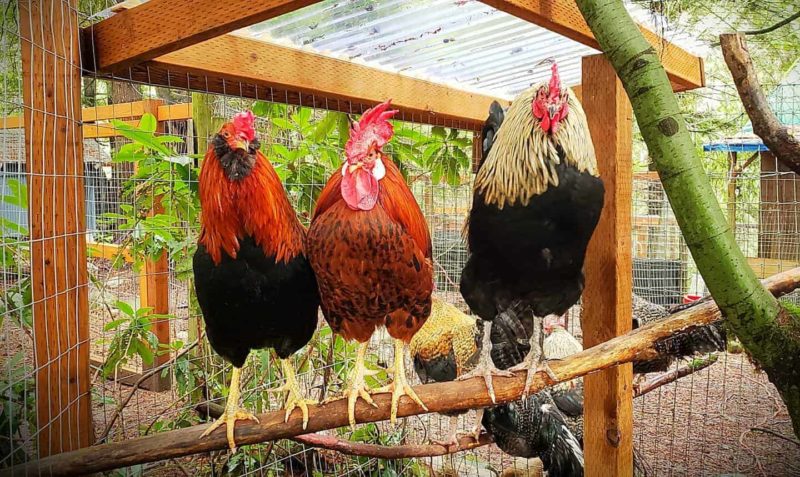
Photo: Rooster Haus Rescue
Updated April 19, 2021
Enrichment is often thought of as an extra or optional provision for residents. Sanctuary workers are understandably focused on providing the food, water, and housing that is necessary for residents to live. However, we are hoping that by incorporating enrichment as an aspect of general care, the lives of residents will be enriched. This is of particular importance for residents residing in smaller, more confined, or barren living spaces. In areas that experience intense cold, the best way to keep chicken residents warm is to leave them in a smaller, coop-like space when they may normally have a larger outdoor space for foraging and other chicken behaviors. In cases like these, enrichment can make a world of difference in the lives of residents. No one likes to be bored, including residents, regardless of species!
Highly Pathogenic Avian Influenza
Due to the growing danger of HPAI great care must be taken to ensure bird residents do not come into contact with wild birds or with water or food or other resources that wild birds have access to. This means that you may have to get extra creative in terms of enrichment to avoid potential transmission. Learn more about HPAI and how you can protect bird residents here.
Developing An Enrichment Plan
It is important to understand the species-specific needs of your residents, as well as to consider their individual needs. An example of a species-specific understanding acknowledges that chickens are very motivated to forage for their food, though some have been bred to exhibit less active behavior, like large breed chickens, who have particular health issues that need to be taken into consideration when developing an enrichment plan. This is critical, as adding roosts, chicken swings, and certain types of nutritional enrichment could prove dangerous for large breed chickens.
Who Are We Talking About When We Say “Large BreedDomesticated animal breeds that have been selectively bred by humans to grow as large as possible, as quickly as possible, to the detriment of their health. Chickens?”
We use the term “large breed” to refer to Cornish crosses and other chickens who have been bred to grow quickly – not as quickly as Cornish crosses, but quicker than other breeds – and are typically marketed as “free-range broilers.” As a group, they are often called “colored hybrid broilers” but include many different Trade names such as Freedom Ranger, Red Ranger, and Kosher King. Though other breeds of chickens, such as Orpingtons and Jersey Giants, are sometimes raised for their flesh, they do not face the same inherent challenges as Cornish crosses and chickens who fall into the category of “free-range broilers,” and are not who we are referring to when we say “large breed.”
For example: On an individual level, Cindy the little brown hen underwent surgery recently and her movements must be limited, especially walking, for the next week or two. Setting Cindy up in a sling or small living spaceThe indoor or outdoor area where an animal resident lives, eats, and rests. and providing enrichment as a means of mental stimulation can assist in her healing. Examples of possible enrichment strategies for Cindy include playing the radio, stringing a treat garland within her reach, adding a familiar smell to her temporary living space, and providing a television or computer screen-savers. (That’s right! Studies have shown that chickens are stimulated by visual enrichment, particularly those involving movement. Images and clips should be rotated every so often to keep their interest.)
When developing an enrichment plan for residents, it’s important to consider the types of behavior in which you’re hoping to see an increase or decrease. For example, if you’re hoping to reduce feather-picking, there are particular enrichment options that are ideal for that, such as tying a bunching of white string to an accessible part of their living space. Do you wish to increase exploratory behavior? Novel objects and nutritional foraging enrichment may be better suited in this case.
Enrichment Is Well Worth The Time Investment!
We know you have your hands full managing a sanctuary and probably never seem to have enough time. However, developing enrichment plans for species, particular groupings of residents, and individuals can actually help you save time and money in the future! Residents who are provided individualized enrichment are more likely to feel mentally stimulated, experience positive emotions, and are more likely to perform satisfying natural behaviors that can help mental and physical health. Happier residents heal more quickly than stressed individuals, and residents with enriched environments may be less likely to engage in confrontationalBehaviors such as chasing, cornering, biting, kicking, problematic mounting, or otherwise engaging in consistent behavior that may cause mental or physical discomfort or injury to another individual, or using these behaviors to block an individual's access to resources such as food, water, shade, shelter, or other residents. behaviors, depending on their living space
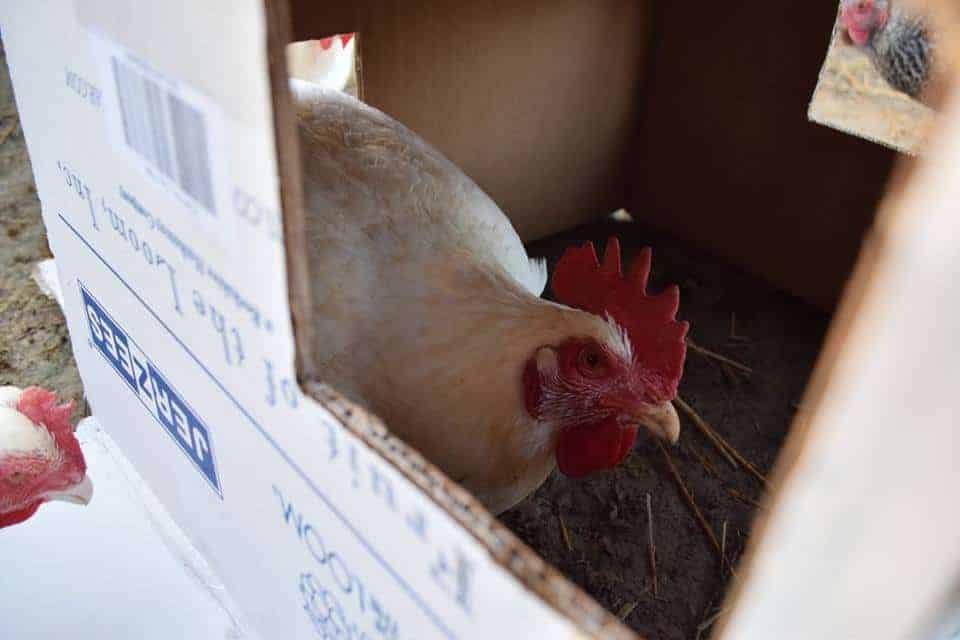
Photo: Piedmont Farm AnimalA domesticated animal that is used by humans either for their body or what comes from their body. Farmed animals have fewer regulations governing their welfare than other species in many countries. Refuge
Now let’s take a look of what an enrichment plan can look like:
Sample Enrichment Plan
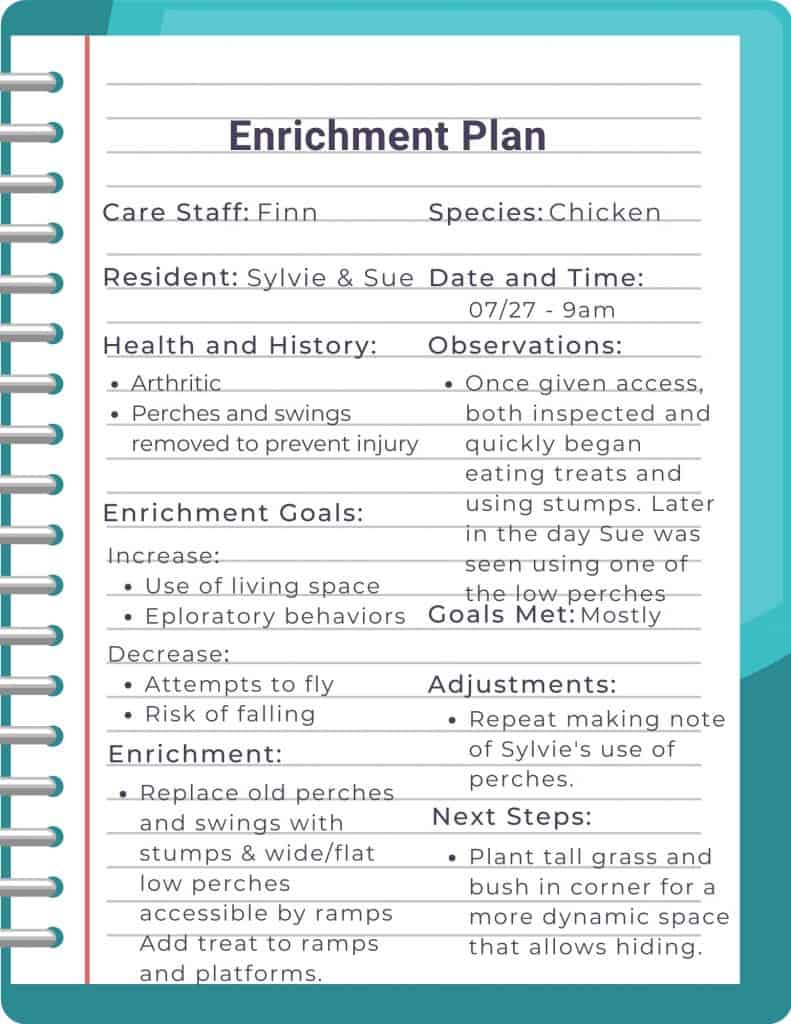
As you can see, enrichment can go beyond just offering toys or treats- and that offering enrichment isn’t just a one-time thing! Residents will become bored with certain enrichment that is left in their living space for an extended period or the same enrichment offered every day (tasty treats being likely an exception to this).
One At A Time!
It is important to only add a single enrichment element at a time when you are first observing and learning whether a resident(s) actually finds it enriching (and for how long they find it enriching before they lose interest). Adding multiple enrichment strategies makes it difficult to get an accurate assessment of the appropriateness of the chosen enrichment. You will be better able to build a schedule when you have more accurate information.
Observations And Adjustments Are Key!
It’s always important to observe if and how residents use the proffered enrichment. Remember, it is only enrichment if the individual finds it enriching! If they are frightened by something or uninterested in it, then it isn’t enriching.
Now that we have covered what an individual enrichment plan looks like, we will cover some of the different types of enrichment for chickens and how they could be implemented at your sanctuary.
Social Enrichment
This one may seem obvious, but it’s important to mention. Chickens are social animals and it’s important they have access to other chickens. Of course, there are times when this isn’t possible, due to medical issues, flock disagreements, or sadly, the death of their flock-mates. In cases like these where direct contact with others of their species isn’t possible, there are ways that you can enrich their lives during this time:
- Ideally, chickens should be housed with other chickens. If this isn’t possible, then extra steps should be taken to alleviate the stress caused by any sense of isolation.
- Provide visual contact with other chickens.
- Add a mirror (some organizations hang old CDs) to their living space.
- Include a small amount of soiled bedding (if contagion isn’t an issue) from their original flock space.
- Play a recording of normal chicken sounds.
- If you have a large breed rooster who can’t be housed with the hens, sometimes they can be integrated into a flock of turkeysUnless explicitly mentioned, we are referring to domesticated turkey breeds, not wild turkeys, who may have unique needs not covered by this resource. or have a turkeyUnless explicitly mentioned, we are referring to domesticated turkey breeds, not wild turkeys, who may have unique needs not covered by this resource. companion.
- House chickens have been known to form strong social bonds with humans as well as some other species, though this should be done thoughtfully and carefully to prevent injury. If possible, consider adopting or rescuing a second chicken.
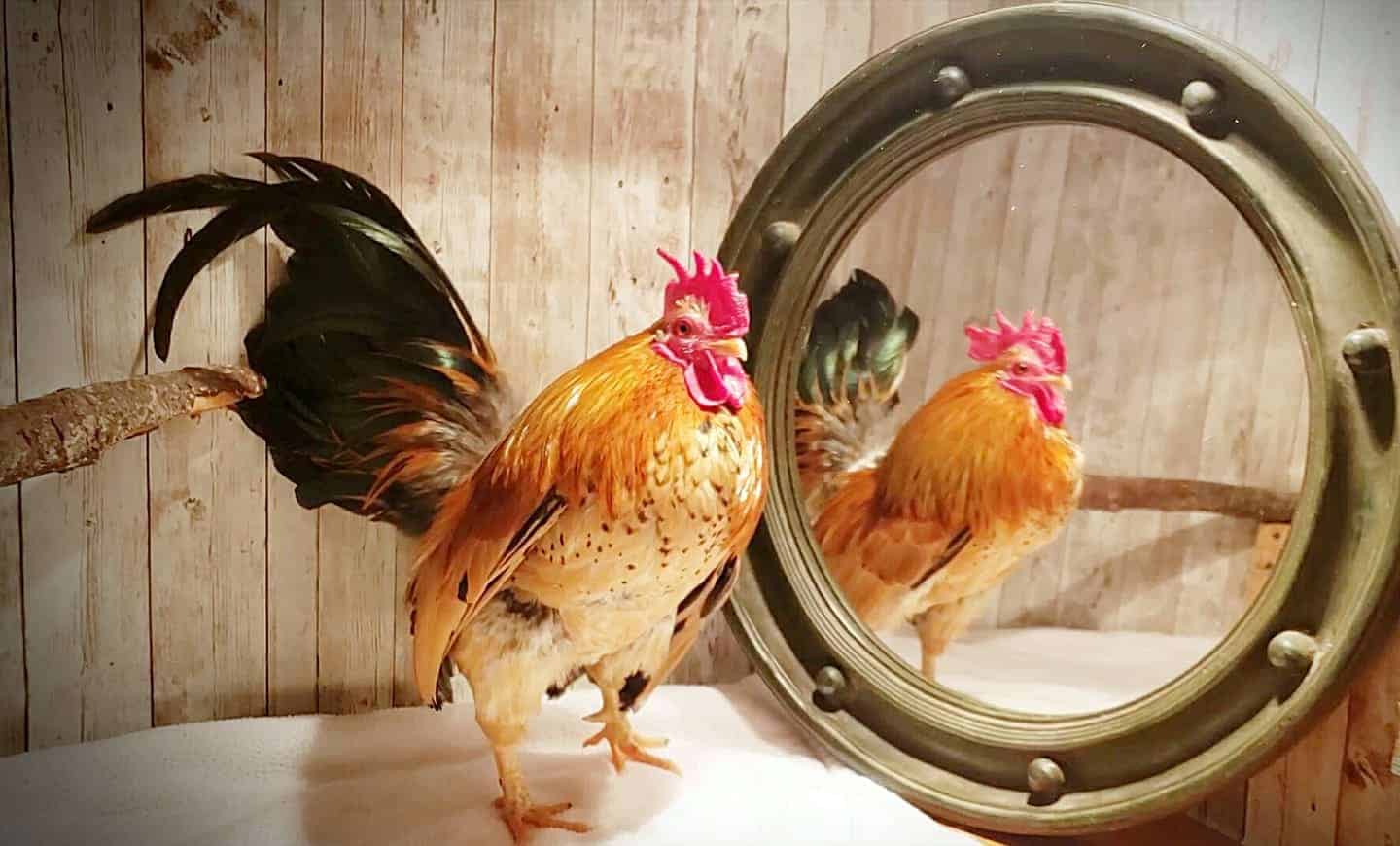
Photo: Rooster Haus Rescue
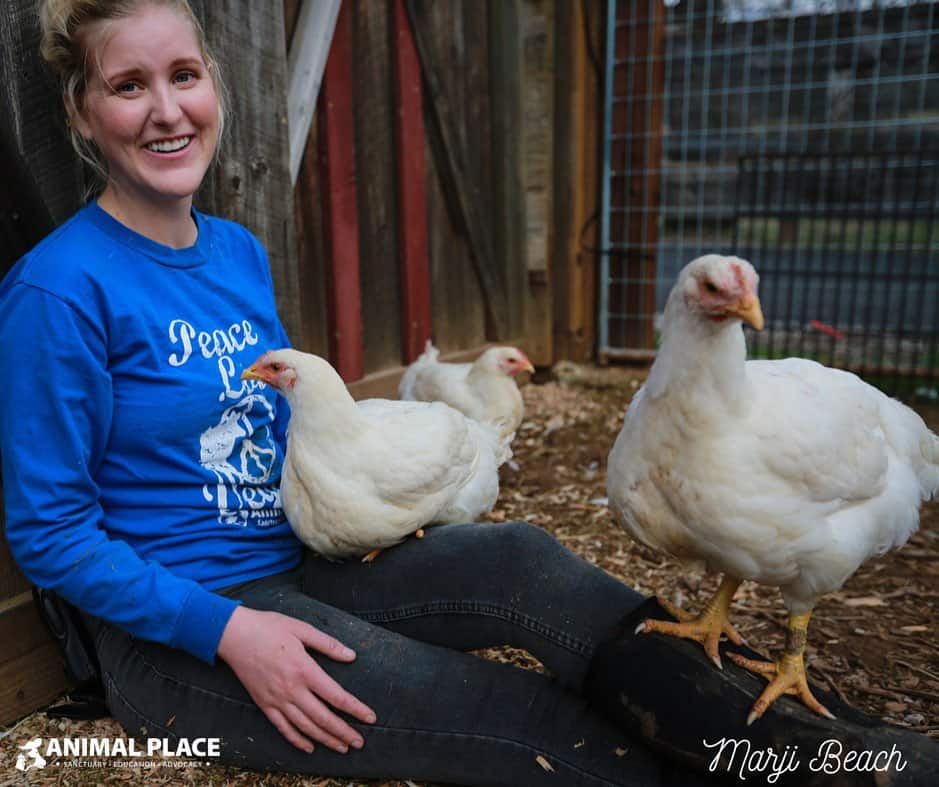
Physical Enrichment
Physical or structural enrichment refers to creating a dynamic living space for residents. Structures, furniture, substrates for digging or dust bathing, hiding, and perching are all examples of physical enrichment! Let’s look at some chicken-specific physical enrichment:
- Add stumps, ramps, and ladders all provide different opportunities to perch and explore.
- Cover some overhead areas to provide a sense of safety and shade to more comfortably allow exploration of the living space.
- Add and secure branches for perches.
- Try out swings and more complex furniture (keeping in mind the needs of the individual).
- Add little curtains to nesting boxes to allow the option for privacy.
- Break up the living space with shrubs, bushes, and grasses.
- Add dirt for nice dust-bathing opportunities.
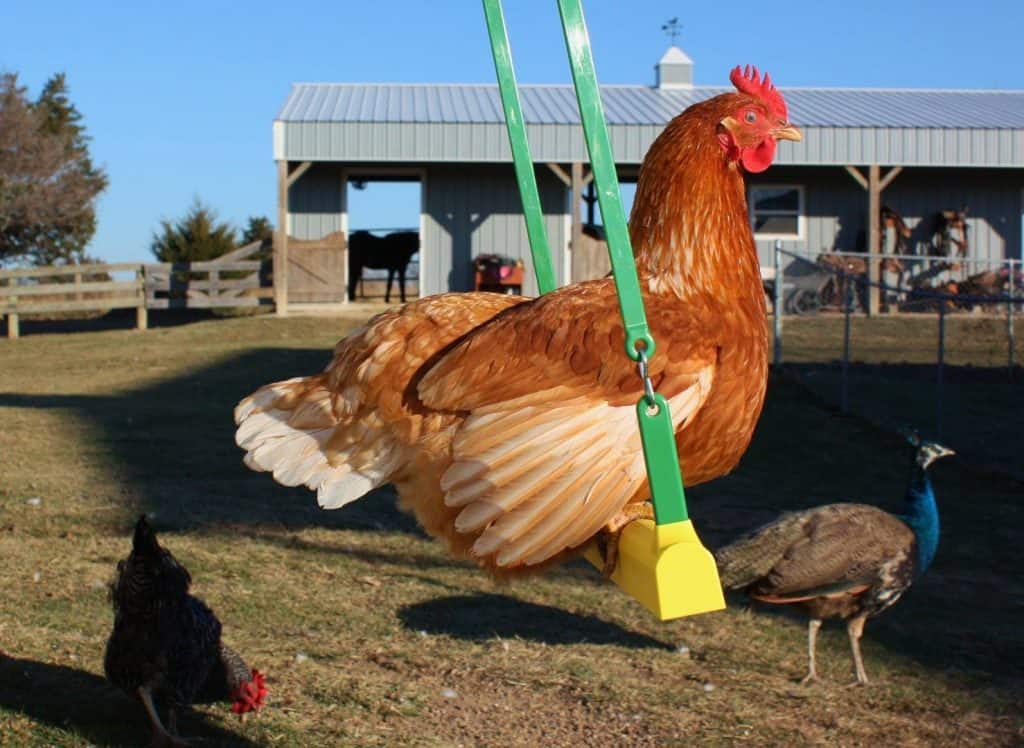
Photo: Animal Place
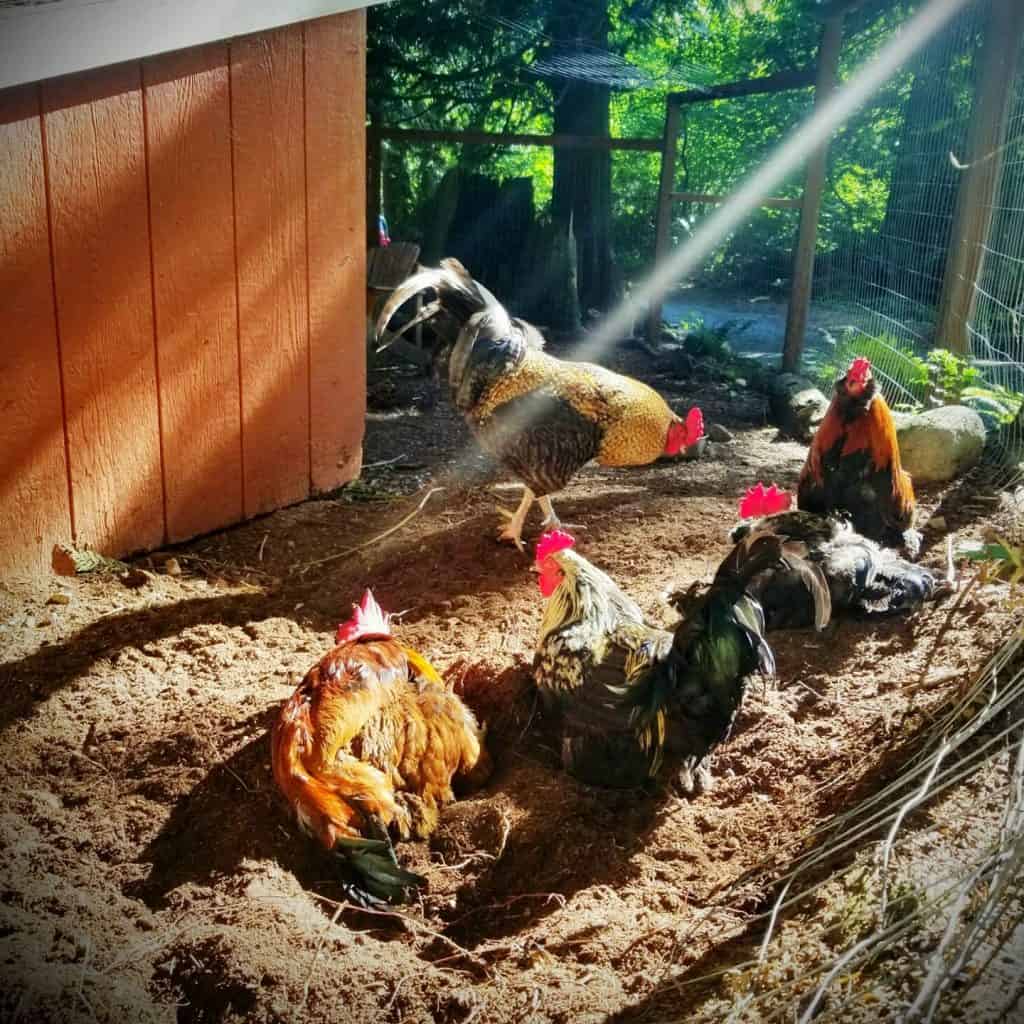
Photo: Rooster Haus Rescue
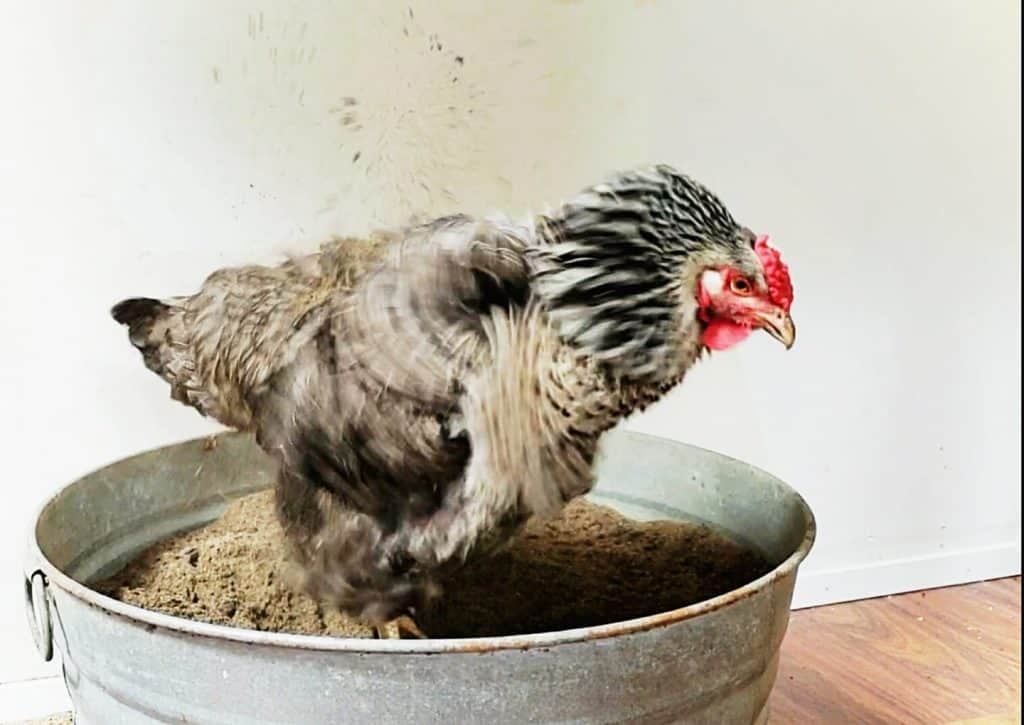
Photo: Rooster Haus Rescue
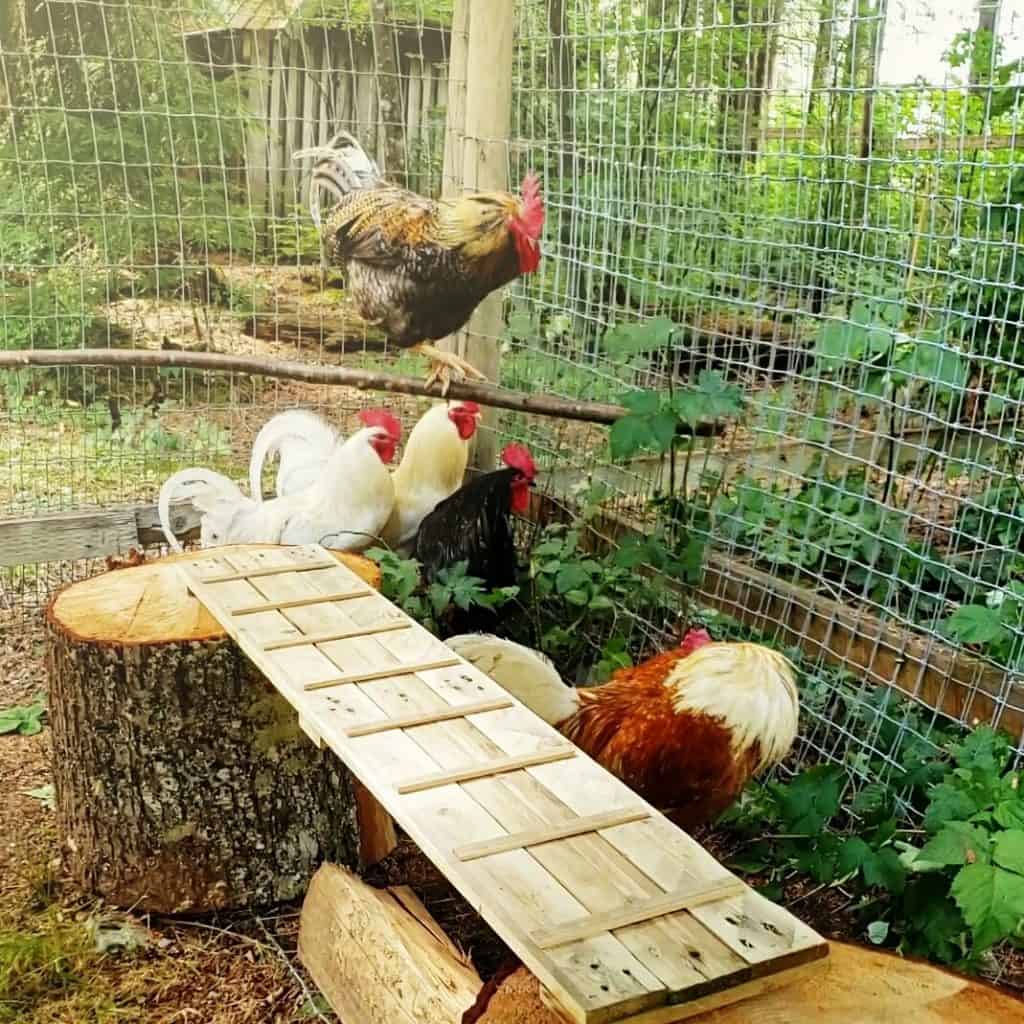
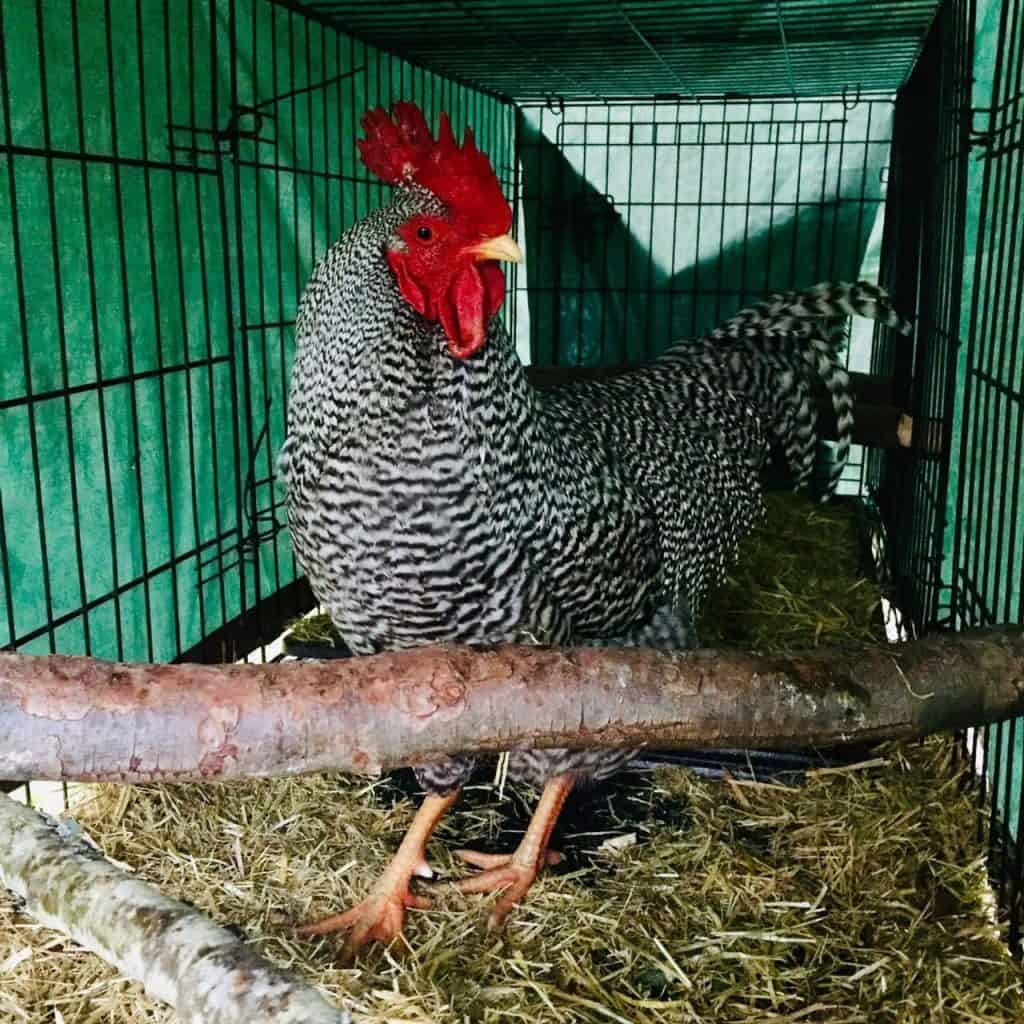
Nutritional Enrichment
This is a fun one! We all know chickens revel in scratching at dirt and foraging and enjoy an array of tasty treats.
Here is a list of ideas for nutritional enrichment for your chicken residents:
- Take a two to three-inch wide PVC pipe and put caps on the ends. The length of the tube could be twelve inches or larger. Drill a handful of holes on the side of the tube, and it becomes a food dispenser when the birds roll and peck at it.
- Another option is to place chicken food in wiffle balls. As the balls roll, treats fall out.
- There are also food balls made specifically for chickens that distribute a small amount of food when the ball is manipulated.
- Some puzzle feeders made for dogs can be used with supervision.
- Hang heads of cabbage or lettuce from a string, making a tasty treat piñata! We recommend covering the string with stiff tubing or a piece of hose to prevent residents from getting tangled in the string.
- Add a pile of leaves (be sure they aren’t toxic to chickens) and sprinkle treats throughout.
- String safe produce and make a garland to hang in their living space.
- Chickens are an amazing species that actually exhibit a behavior called contrafreeloading. Contrafreeloading is the term for when an animal will choose to perform a task to receive food even when there is food readily available. This is most evidently seen in red jungle fowl, from which domesticatedAdapted over time (as by selective breeding) from a wild or natural state to life in close association with and to the benefit of humans chickens descend. Red jungle fowl exhibit this behavior most, with domesticated chickens following, though large breed chickens tend to exhibit less of this behavior. See an example of a chicken performing as task for food here.
- If you think hiding a bird’s food or making them work for their food is unkind, you can try an experiment with your residents. Provide a puzzle with food in it next to a bowl of food, and see how your residents behave.
- When temperatures are hot, add chopped up produce to a mold, add water and freeze, creating a cool treat that can keep your residents engaged on a hot day.
Check out our resource on safe treats for chicken residents here!
Chicken Resident Safety
While a common practice at many sanctuaries and directly experienced by members of our staff, we did receive a concerning report from a sanctuary that frozen treats caused internal injury to several chicken residents. Staff report that their veterinarian listed tissue damage from frostbite, pain/cold sensitivity, and localized hypothermia as potential health concerns from feeding birds frozen treats. They recommended offering refrigerated treats instead. We are looking into it and will update our guidance as we learn more! Please reach out to us if you have experienced this at your sanctuary.
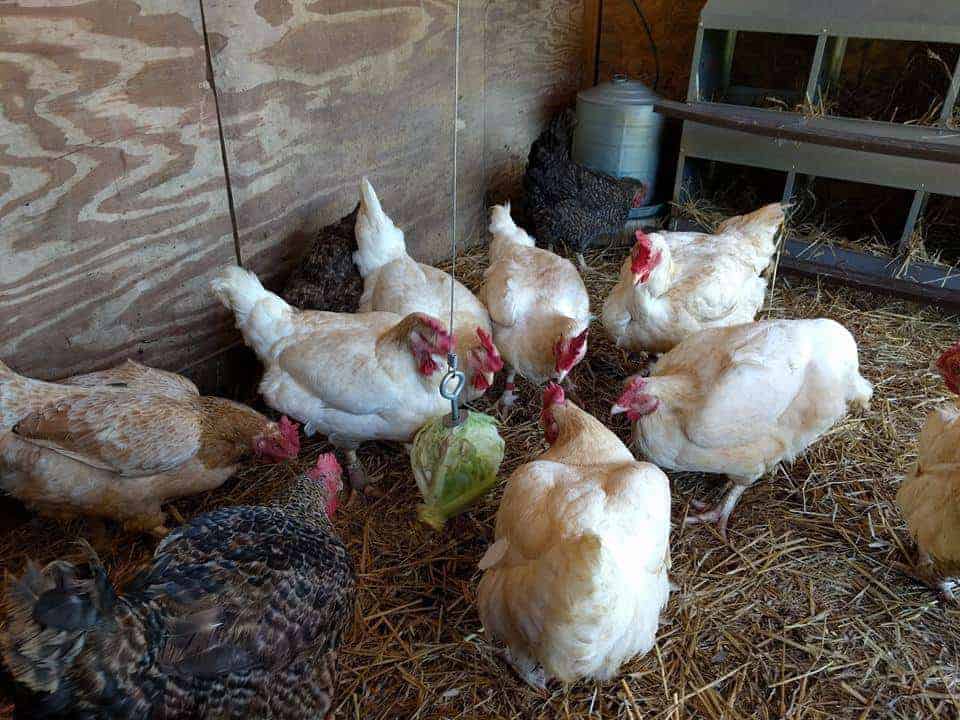
Photo: Piedmont Farm Animal Refuge
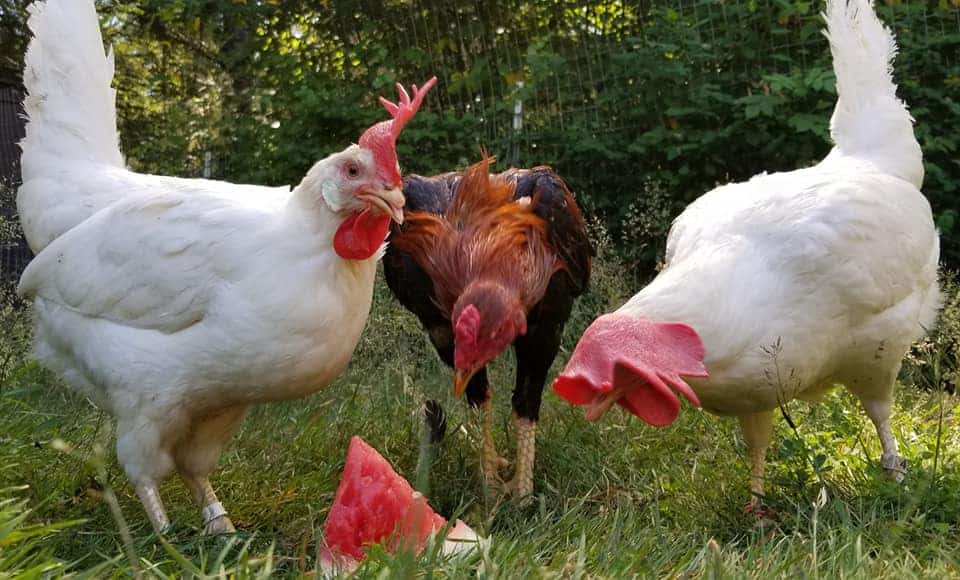
Photo: Rooster Haus Rescue
Large breed chickens (such as Cornish-Cross individuals) have been bred to gain weight in a short period of time, and spend a lot of their time hungry and motivated to eat. You can still carefully allow your large breed residents to exhibit natural behaviors such as foraging without causing them harmThe infliction of mental, emotional, and/or physical pain, suffering, or loss. Harm can occur intentionally or unintentionally and directly or indirectly. Someone can intentionally cause direct harm (e.g., punitively cutting a sheep's skin while shearing them) or unintentionally cause direct harm (e.g., your hand slips while shearing a sheep, causing an accidental wound on their skin). Likewise, someone can intentionally cause indirect harm (e.g., selling socks made from a sanctuary resident's wool and encouraging folks who purchase them to buy more products made from the wool of farmed sheep) or unintentionally cause indirect harm (e.g., selling socks made from a sanctuary resident's wool, which inadvertently perpetuates the idea that it is ok to commodify sheep for their wool). from overeating with tools like slow feeders. There are also food balls made specifically for chickens that distribute a small amount of food when the ball is manipulated. However, although chickens as a species have shown interest in working for their food even when other food is readily available, this behavior is seen less in large breed chickens. This enrichment may potentially provide the desired stimulation, or may not be of interest to your large breed birds at all.
Sensory Enrichment
Sensory enrichment refers to enrichment that engages the senses. Arguably all enrichment engages the senses, but sensory enrichment focuses in on sight, touch, hearing, and smell. Each can provide interesting experiences for chicken residents!
Visual Enrichment
Research has shown that chickens can benefit from visual forms of enrichment. In particular, studies revealed that chickens who have been given visual forms of enrichment exhibit less fear when they are transferred to unfamiliar environments. Visual enrichment could include:
- Computer screen savers, particularly those that move
- Television or movies.
- Images of chickens projected onto walls has shown behavioral imitation among the flock it is shown to. So projecting scenes of happy chickens may help your resident chickens feel good too. Interest in images may fade after a few weeks and thus should be changed routinely to sustain interest.
- Provide mirrors or hang CDs around their living space. Note: Be mindful of individual personalities when adding mirrors around roosters. This may not be an ideal form of enrichment for them if they exhibit confrontational behaviors.
- Place a pinwheel outside of their living space
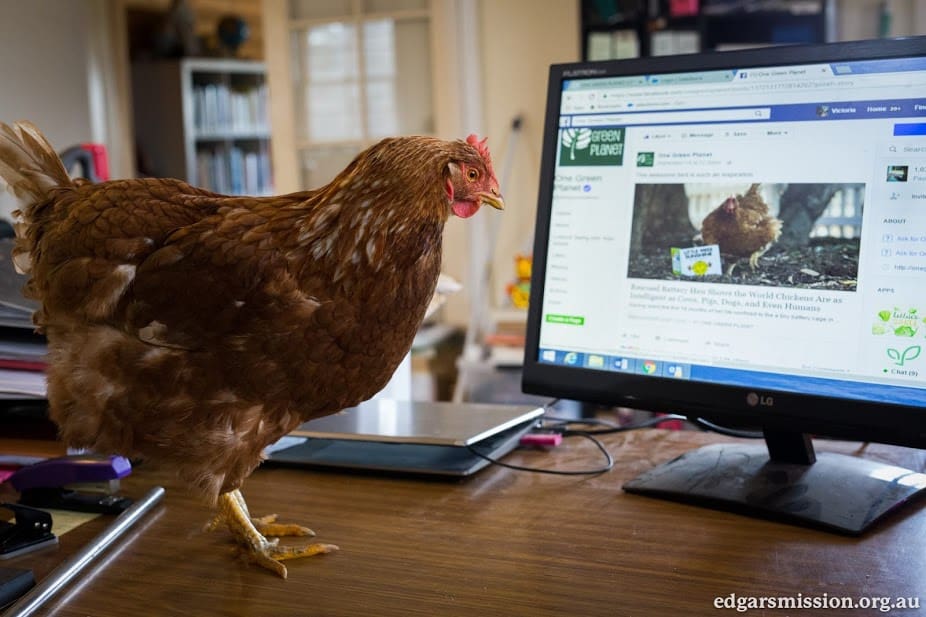
Photo: Edgar’s Mission Farm Sanctuary
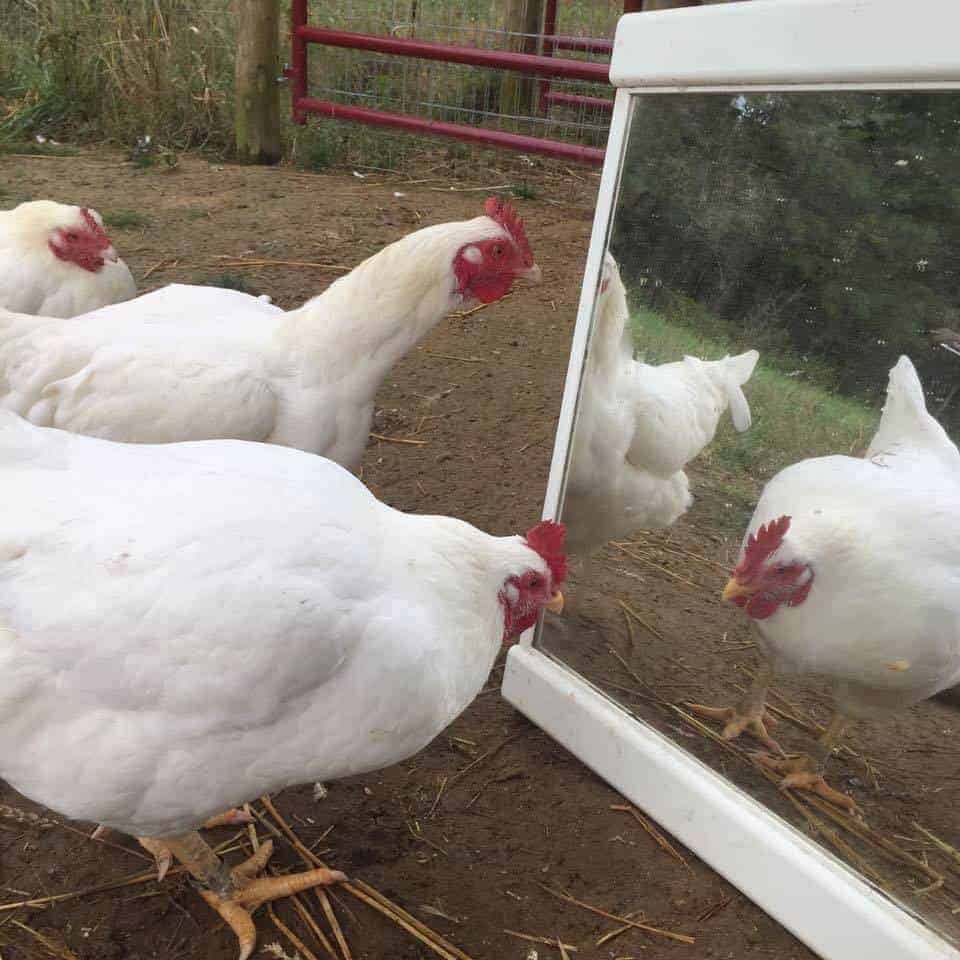
Photo: Piedmont Farm Animal Refuge
Olfactory Enrichment
Olfactory enrichment is often overlooked when considering chickens. However, studies have shown that chickens have an advanced sense of smell, and providing chickens access to certain smells can contribute to feelings of safety though these studies focus more on the familiarity of smell than the properties of a scent itself..
- If you need to transfer a chicken to a new living space, add a bit of soiled bedding from their previous space.
- Chicks have been shown to prefer smells like vanilla over garlic.
- Chicks exposed to geraniol oil exhibited an increase in pecking, vocalization, preening, and movement.
- If introducing new birds to an existing flock, the presence of vanilla scent may have a calming effect if both living spaces where the birds resided had vanilla in them as well.
Auditory Enrichment
Do you love a good tune? Or have a favorite song that soothes you? The same can be true for chickens!
- Chickens have been shown to experience reduced fear when classical music is played for them!
- Other studies have shown that playing a radio for hens made them calmer.
- Natural sounds for chickens can be soothing, but were not shown to be as helpful as music.
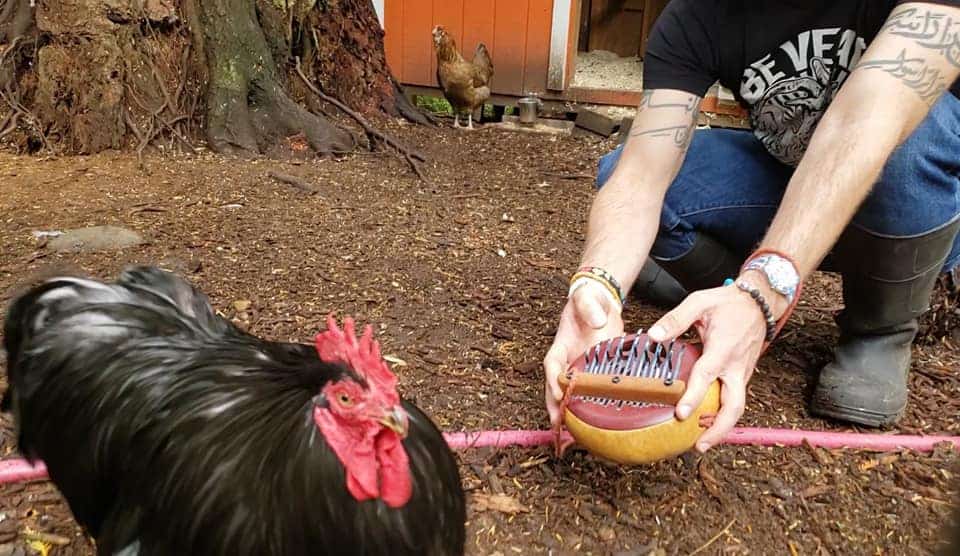
Photo: Rooster Haus Rescue
Tactile Enrichment
To encourage chickens to interact with their environment and redirect otherwise problematic behavior, consider adding tactile enrichment to their living spaces. This might include:
- Tying a bunch of white strings in their living space (being careful that they cant ingest them).
- Adding sand or dirt for a nice dust bath can be stimulating and help keep ectoparasite infestations down.
- Add colorful balls (large enough that they can’t swallow them and made from material they cannot digest) to food dishes.
- Add a cat toy to their living space (that they cannot ingest).
- Place a soccer ball or tennis ball for them to interact with into their living space.
- Add chicken swings, unique roosting opportunities (like wooden ladders or chicken “playgrounds”). However, it is important to consider the needs of your individual residents. Structures like these may not be advisable for senior and large breed chickens as they could result in serious injury.
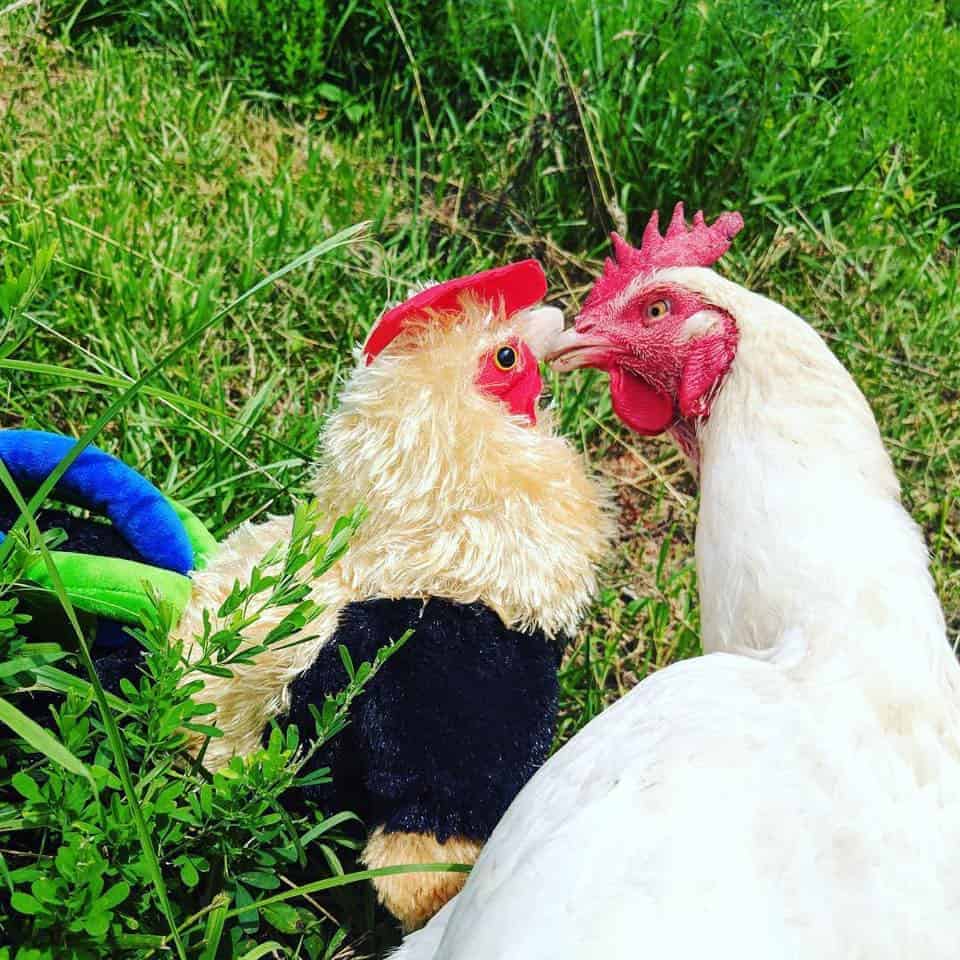
Photo: Piedmont Farm Animal Refuge
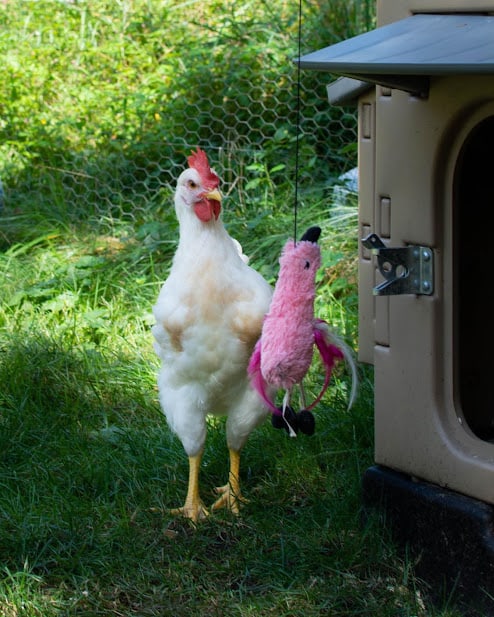
Photo: Safe Haven Farm Sanctuary
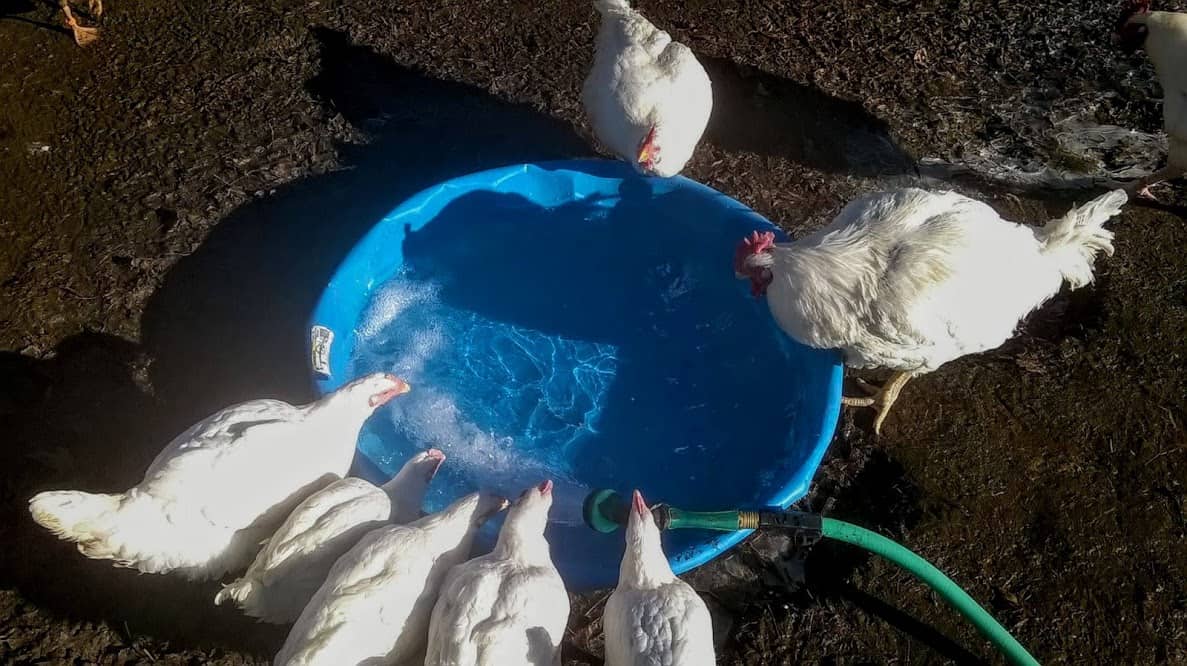
Photo: Safe Haven Farm Sanctuary
Cognitive Enrichment
Cognitive enrichment involves experiences or environments that encourage curiosity, problem solving behaviors, and learning. A number of enrichment strategies listed above also fall into this category. Puzzle feeders and going on walks in safe areas with a resident comfortable wearing a harness vest are great examples of this. But lets touch on another form of cognitive enrichment: positive reinforcement learning (This is often referred to as “training”, but we feel “learning” and “engagement” are better descriptions of this in a sanctuary environment.)
- Positive Reinforcement Engagement
- Many chickens may enjoy interacting with their human caretakers. One way to build a strong human-chicken bond and boost cognitive functioning in your chicken residents is to engage in clicker “training” (we prefer the terms “bonding” or “engagement”). Clicker bonding and positive reinforcement are not interchangeable words. However, a clicker can be a useful tool during positive reinforcement engagement!
- Examples of activities to learn with your chicken residents could include learning to choose a specific shape or color and rewarding with an immediate click and treat. Other examples include teaching chickens to come to the call of their name, how to ring a bell, and into more challenging tasks such as picking a specific card from a deck, pecking at a lever to release food (remember contrafreeloading?), walking through agility courses, and even learning to play tic-tac-toe. Positive reinforcement can also be used to ease medical procedures and transfers. This infographic from Poultry DVM provides a brief tutorial on how to engage chickens with a clicker.
- As noted in nutritional enrichment, certain feeders require a resident to figure out how to manipulate an object so that it will release the treats.
- Providing a changing, engaging enrichment schedule will overall stimulate residents’ minds.
Focus On The Resident
It is important to note that clicker learning or play should only be implemented for the positive experiences that can be provided to your residents. This should not be used to encourage behavior that might be unsafe or exploitative.
Take Notes
Because every chicken is an individual, they are likely to have individual responses to enrichment. When you first add enrichment items, be sure to carefully observe the reactions of your residents. To prevent discomfort to new items or enrichment schedules, consider adding novel objects to an area to the side of their enclosure or in a space that doesn’t require them walking past the item to go inside, outside, or reach their water or food. If you believe one of your resident flocks or individuals may be fearful of certain enrichment, encouraging them to investigate object while you are sitting and holding the object can help ease fears. Using food or treats to motivate them to interact with the item is a great way to start. Giving your residents the option to engage or not with enrichment items can be empowering and improve emotional states. Be sure to make notes of any reactions and when their level of interest seems to subside. This will help you know how to best schedule days to change up their enrichment and provide them with a mentally stimulating environment.
Novelty
Novelty can be enriching on its own. Making changes to the “furniture” arrangement, placement of food, addition of balls, toys, and swings, can all create an interesting an enriching environment for your chicken residents. Chickens are clever and become bored after some time with provided enrichment. For this reason, it is important to incorporate “switch it up” days into your residents’ enrichment schedules. As mentioned above, it’s important to take notes on flock and individual responses so you can properly tailor enrichment to the interests and needs of your residents.
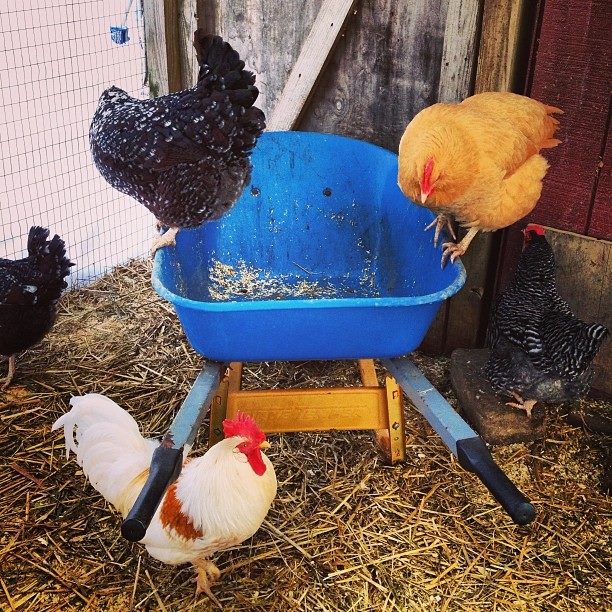
Photo credit: Lewis Oliver Farm Sanctuary
Building A Schedule
Once you learn more about your residents’ interests, you can build an enrichment schedule to provide varying forms of enrichment as part of your caretaking routine. This will keep things interesting for the chickens and help provide a stimulating and happy life for your residents.
Do you have an exciting enrichment strategy you use with your chickens? Tell us all about it!
SOURCES:
Environmental Enrichment Ideas For Poultry | Poultry DVM
Enrich Your Chickens’ Environment For Better Health | Hobby FarmsFor-profit organizations focused on the production and sale of plant and/or animal products. (Non-Compassionate Source)
Environmental Enrichment For Poultry Welfare (Non-Compassionate Source)
The Effects Of Four Types Of Enrichment On Feather-Pecking Behaviour In Laying Hens Housed In Barren Environments | Animal Welfare (Non-Compassionate Source)
Domestication Effects On Foraging Behaviour – Consequences For Adaptability In Chickens | Linköping Studies in Science and Technology, Christina Lindqvist (Non-Compassionate Source)
Do You Need Toys For Chickens? | Backyard Poultry (Non-Compassionate Source)
If a source includes the (Non-Compassionate Source) tag, it means that we do not endorse that particular source’s views about animals, even if some of their insights are valuable from a care perspective. See a more detailed explanation here.








